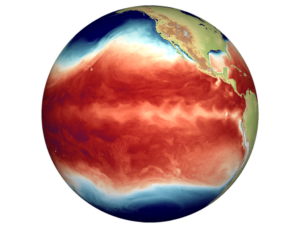A collaborative study on the climate phenomenon known as El Niño, involving scientists from Met Éireann, and fellow researchers from the USA, South Korea and Germany, has been published in the open access research journal, Nature Communications.
October, 2025
The team of researchers found that the El Niño southern oscillation could intensify rapidly over the coming decades and synchronize with other major climate phenomena, reshaping global temperature and rainfall patterns by the end of the 21st century.
What is ‘El Niño’?
El Niño refers to warm surface waters in the Eastern tropical Pacific that were first observed in the disruption of fish stocks for Peruvian fishermen several centuries ago. The name comes from the Spanish word for ‘boy’, with the opposite phenomenon, i.e. cold and nutrient rich waters upwelling to the surface of the Eastern tropical Pacific, known as La Niña, the Spanish for ‘girl’.
In a climatic context, we refer to the El Niño phenomenon as the oscillation between warm Eastern tropical Pacific sea surface temperature conditions (El Niño) and cold Eastern tropical Pacific sea surface temperature conditions (La Nina). This natural fluctuation between the two conditions influences weather and climate worldwide, including as far away from the Pacific as in Europe, with the entire oscillation process taking up to a few years in time.

Figure 1: A snapshot of eastern Pacific sea surface temperatures, showing temperature pattern for a typical La Niña event, with equatorial cold temperatures and wave-like structure west of the Galapagos Islands simulated by a high-resolution climate model. Blue to red colour shading indicates transition from colder to warmer surface conditions. The amplitude of La Niña and El Niño conditions can intensify in response to global warming and the succession of these extremes will also become more regular
The new Nature Communications study concludes that El Niño will intensify and synchronize with other climate phenomena.
In the present climate, the influence of El Niño / La Niña on the climate of Ireland is not very pronounced, but according to the high-resolution computer model simulations analysed in this study, there would be an increasing impact on Europe in the future, starting at some point in the second half of this century.
This new study concludes that, in a warmer world, both El Niño and La Niña conditions would get stronger and more regular, alternating every few years. Additionally, the El Niño cycles are expected to synchronise with other climate phenomena, such as the North Atlantic Oscillation (NAO), a wind pattern oscillation over the North Atlantic, therefore having a stronger impact on Europe’s climate.
Met Éireann researcher and study co-author, Dr Tido Semmler, says:
“Our study findings underscore the need for global preparedness to address intensified climate variability and its cascading effects.
“In El Niño years, NAO ‘minus’ would preferably occur, leading to colder, calmer and drier than average winters in Ireland, with a tendency towards weather episodes with a continental influence. In La Niña years, NAO ‘plus’ would preferably occur, leading to stormier, wetter, and milder winters, with a stronger influence of the North Atlantic Ocean on Irish climate. As a result, Irish winter variability would increase, leading to a higher probability of extreme events.”
Dr Semmler continues: “El Niño and La Niña also have implications for global average temperatures. El Niño tends to lead to higher-than-normal global average temperatures, while La Niña tends to lead to lower-than-normal global average temperatures. This is overlaid on the global warming trend so that in La Niña years the trend might be temporarily masked, while in El Niño years, it would be accelerated.”
The climate simulations used in this study assume a scenario of strongly increasing greenhouse gas concentrations. The shift towards more extreme El Niño and La Niña conditions climate can be delayed or potentially even avoided when reducing greenhouse gas emissions in a global effort.
Notes:
Global climate mode resonance due to rapidly intensifying El Niño-Southern Oscillation | Nature Communications. Stuecker, M. F., Zhao, S., Timmermann, A., Ghosh, R., Semmler, T., Lee, S.-S., Moon, J.-Y., Jin, F.-F., and Jung, T. (2025).
For more information or interview opportunities with Dr Semmler, please contact: media@met.ie.